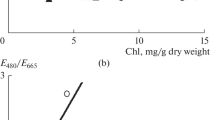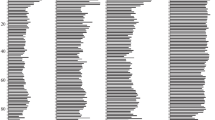Abstract
Results of studying spatial and temporal variability in plant pigments in the Volga River water from the upper sections of the Ivankovo Reservoir downstream to the Rybinsk Reservoir Main Reach, as well as the applicability of different groups of indices of the absolute and relative concentration of pigments (chlorophylls, phaeo-pigments, and carotenoids) are presented. To differentiate water masses, these pigments have been assessed using the standard spectrophotometric method. It has been found that waters of individual river sections, singled out according to their hydrological features, and waters of different reservoirs on the whole can be reliably distinguished according to the concentration of pigments in the plant suspension.
Similar content being viewed by others
References
Ivan’kovskoe vodokhranilishche i ego zhizn’ (Ivankovo Reservoir and Its Life), Leningrad: Nauka, 1978.
Korneva, L.G., Present-Day State of Phytoplankton in The Upper Volga Reservoirs, in Biologicheskie resursy, ikh sostoyanie i ispol’zovanie v basseine Verkhnei Volgi (Biological Resources, Their State and Use in the Upper Volga Basin), Yaroslavl: Izd. YarGU, 1999, pp. 81–91.
Kurdina, T.N., Hydrological Regime Elements and Water Balance of the Uglich Reservoir, Tr. Inst. BV AN SSSR, 1959, iss. 2 (5), pp. 229–245.
Mineeva, N.M. and Mitropol’skaya, I.V., Composition and Production of Phytoplankton in Adjacent Parts of the Rybinsk and Gorkii Reservoirs, Biologiya Vnutr. Vod, 2002, no. 4, pp. 25–33.
Pyrina, I.L., Long-Term Studies of Phytoplankton Pigment Concentrations in the Rybinsk Reservoir, Biologiya Vnutr. Vod, 2000, no. 1, pp. 37–44.
Pyrina, I.L and Sigareva, L.E., Phytoplankton Pigment Concentrations in the Rybinsk Reservoir in Years with Different Hydrometeorological Conditions (1972–1976), in Biologiya i ekologiya vodnykh organizmov (Biology and Ecology of Aquatic Organisms), Leningrad: Nauka, 1986, pp. 65–89.
Sadchikov, A.P., Transformation of Organic Matter by Bacterial Community in Water Bodies with Different Trophic Levels, Gidrobiol. Zh., 2001, vol. 37, no. 3, pp. 87–92.
Sigareva, L.E., Pigment Criteria for the Assessment of the Environmental Condition of a Water Body, in Biogeokhimicheskie osnovy ekologicheskogo normirovaniya (Biogeochemical Principles of Ecological Standardization), Moscow: Nauka, 1993, pp. 64–69.
Sigareva, L.E., Pigment Model of Phytoplankton and Its Use, Metodicheskie Voprosy Izucheniya Pervichnoi Produktsii Planktona Vnutrennikh Vodoemov (Methodological Issues of Studying Planktonic Primary Production of Inland Water Bodies), St. Petersburg: Gidrometeoizdat, 1993, pp. 120–125.
Sigareva, L.E. and Timofeeva, N.A., Studying the Correlation between the Plant Pigments Content of Bottom Deposits and the Trophic Status Indices of the Gorky Reservoir, Vodn. Resur., 2001, vol. 28, no. 6, pp. 742–751 [Water Resour. (Engl. Transl.), vol. 28, no. 6, pp. 678–687].
Fortunatov, M.A., Water Color Index and Transparency of the Rybinsk Reservoir, Tr. IBV. AN SSSR, 1959, no. 2 (5), pp. 246–357.
Edel’shtein, K.K., Vodnye massy dolinnykh vodokhranilishch (Water Masses of Valley Reservoirs), Moscow: Mosk. Gos. Univ., 1991.
Edel’shtein, K.K., Vodokhranilishcha Rossii: ekologicheskie problemy, puti ikh resheniya (Reservoirs of Russia: Environmental Problems and the Ways for Their Solution), Moscow: GEOS, 1998.
Ekologicheskie problemy Verkhnei Volgi (Environmental Problems of the Upper Volga), Yaroslavl: Izd. YaGTU, 2001.
Ekologicheskie faktory prostranstvennogo raspredeleniya i peremeshcheniya gidrobiontov (Ecological Factors of Space Distribution and Movement of Aquatic Organisms), St. Petersburg: Gidrometeoizdat, 1993, p. 336.
Lorenzen, C.J. and Jeffrey, S.W., Determination of Chlorophyll in Sea Water. UNESCO Technical Paper in Marine Science 35, Paris: UNESCO, 1980.
Author information
Authors and Affiliations
Additional information
Original Russian Text © L.E. Sigareva, I.L. Pyrina, 2006, published in Vodnye Resursy, 2006, Vol. 33, No. 4, pp. 475–483.
Rights and permissions
About this article
Cite this article
Sigareva, L.E., Pyrina, I.L. Plant pigments as indicators of water transformation in the upper Volga Chain of reservoirs. Water Resour 33, 436–445 (2006). https://doi.org/10.1134/S0097807806040099
Received:
Issue Date:
DOI: https://doi.org/10.1134/S0097807806040099




